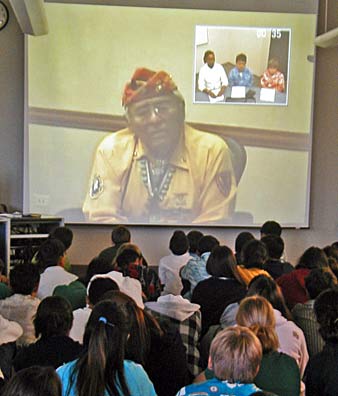
|
Mid-Pacific students get
firsthand history lesson
A Navajo code-talker shares
his Iwo Jima experiences
during a live Webcast
Navajo code-talker Teddy Draper Sr.'s World War II stories made quite an impression yesterday with students at Mid-Pacific Institute.
It was a rich and rare experience for sixth-graders who heard about the history of Navajo code-talkers and the invasion of Iwo Jima directly from someone who played a role in both.
During World War II, Draper and about 400 Navajos used their language to encrypt battle codes, which were never broken by enemy forces. Draper also sustained serious injuries from a mortar blast during the Battle of Iwo Jima. But it would take a nearly six-decade struggle to be rewarded with a Purple Heart.
Mid-Pacific student Katie Plunkett Franklin, 12, was one of eight students from her school selected to ask questions.
"I thought it was an absolutely amazing experience," she said. "It's one that most kids wouldn't have."
Draper talked during a live videoconference from Guam to sixth-graders at Mid-Pacific's Technology Center and students at Dine College, Navajo Nation, in Arizona about the Battle of Iwo Jima and his recent return to Japan.
The conference was sponsored by the Arizona Memorial Museum Association. It was also available to the public through a Webcast over the Internet.
Draper, 81, joined other World War II veterans on a trip to Iwo Jima to commemorate the 60th anniversary of that battle. Draper told students -- in English and his native language -- how he was a bit shaky about returning to the battleground, and the difficulty of finding exact locations due to the thick vegetation.
Draper's son, Teddy Jr., who helped his father answer students' questions, said the American flag raised by Marines atop Mount Suribachi still remains.
Draper also shared with students his experience when he first arrived on the Japanese island aboard a Higgins boat during the war.
"There was a tremendous amount of fire. It was smoky. It was a living hell," Draper said through his son. Artillery from Japanese soldiers came down like hail, he added.
Two weeks ago, Mid-Pacific students met with Draper during a stopover in Honolulu from Iwo Jima. "It can't get much better than that. You can't get more precise information," Franklin said.
"It's so boring when you have to learn it from a textbook," she said. "I thought meeting Mr. Draper was an honor."
Said Lisa Mah, a sixth-grade social studies teacher: "For any teacher, our goal and our mission is to create meaningful learning experiences. To provide this experience, to me, in two words, it's invaluable and priceless."
Draper, of the Navajo Reservation in Canyon de Chelly, Ariz., was discharged from the U.S. Marine Corps in 1946.
The involvement of code-talkers in the war helped save many lives. But they were not given the right to vote at the time, said Draper Jr. The work of the code-talkers remained a secret for years until the code was declassified in 1968.
In 2003, Draper was awarded the Purple Heart for his service and obtained full veteran benefits. The movie "Windtalkers" was released that same year based on the code-talkers.
[News] [Business] [Features] [Sports] [Editorial] [Do It Electric!]
[Classified Ads] [Search] [Subscribe] [Info] [Letter to Editor]
[Feedback]
